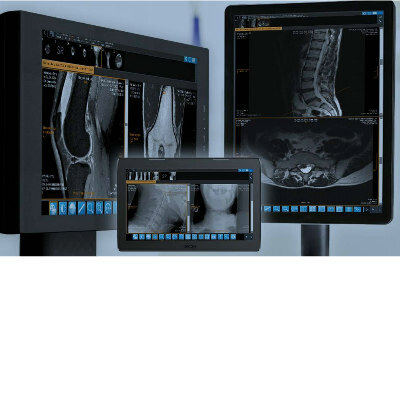Robot-Assisted Needle Positioning in CT-Guided Procedures Improves Accuracy
|
By MedImaging International staff writers Posted on 07 Mar 2023 |

Percutaneous image-guided needle interventions are generally performed for diagnostic and therapeutic purposes, such as biopsies and ablations. In such procedures, the interventional radiologist (IR) usually performs a freehand needle positioning using imaging modalities, such as ultrasound, magnetic resonance imaging, or computed tomography (CT). It can be challenging to achieve accurate needle positioning, especially in out-of-plane approaches. Over the past decades, robots have been developed to improve the precision of needle positioning. To improve needle positioning accuracy, robotic systems have been developed over the past few decades. For their effective application in clinical practice, these robotic systems must support a wide range of entry points and needle path angles that allow for optimal trajectory choices. In addition to accurate needle positioning, robotic systems may also offer the potential for reduced radiation exposure and shorter procedure times, irrespective of the practitioner's experience. Now, a new study has found that robotic assistance for needle positioning during CT-guided biopsy increases accuracy without increasing procedure times.
During procedures requiring needle positioning, robot assistance results in fewer adjustments in comparison to freehand techniques, even for seasoned interventional radiologists, according to the findings of a study by researchers at Radboud University Medical Center (Nijmegen, The Netherlands). For this study, the researchers used NDR Medical Technology’s (Singapore) ANT-C system that is designed to plan needle trajectory and orient physicians to insert needles manually with great accuracy. ANT-C is not a floor-mounted system, allowing it to be used with any CT scanner, and can also help position multiple needles based on just one scan.
Experts utilized an abdominal phantom to compare robot-assisted needle placements with those executed by an interventional radiology fellow and an experienced interventional radiologist. The analysis involved a total of 12 positionings. According to the results, the robot system significantly improved the number of successful needle targets (20/24 vs. 14/24), while providing greater precision, requiring fewer adjustments in contrast to freehand positioning. There was no significant difference in procedure times between the two methods (19.5 ± 9.2 minutes with robotic assistance vs. 21.0 ± 6.9 minutes freehand). Although the fellow experienced more significant benefits from the assistance, both providers' performance showed improvement with the use of the robotic system.
The researchers acknowledge that the ANT-C system is technically feasible and provides potential for use in clinical settings. However, more research is required to assess whether robotic assistance can improve outcomes and its impact on radiation dose in human patients. While there is a high likelihood that robot assistance can enhance accuracy, speed up procedures and lower radiation exposure, other factors need to be evaluated before its implementation. Factors such as installation, sterilization, and costs can vary widely based on the type of system used. Therefore, the researchers have emphasized the importance of evaluating these adjunct factors.
Related Links:
Radboud University Medical Center
NDR Medical Technology
Latest General/Advanced Imaging News
- New AI Method Captures Uncertainty in Medical Images
- CT Coronary Angiography Reduces Need for Invasive Tests to Diagnose Coronary Artery Disease
- Novel Blood Test Could Reduce Need for PET Imaging of Patients with Alzheimer’s
- CT-Based Deep Learning Algorithm Accurately Differentiates Benign From Malignant Vertebral Fractures
- Minimally Invasive Procedure Could Help Patients Avoid Thyroid Surgery
- Self-Driving Mobile C-Arm Reduces Imaging Time during Surgery
- AR Application Turns Medical Scans Into Holograms for Assistance in Surgical Planning
- Imaging Technology Provides Ground-Breaking New Approach for Diagnosing and Treating Bowel Cancer
- CT Coronary Calcium Scoring Predicts Heart Attacks and Strokes
- AI Model Detects 90% of Lymphatic Cancer Cases from PET and CT Images
- Breakthrough Technology Revolutionizes Breast Imaging
- State-Of-The-Art System Enhances Accuracy of Image-Guided Diagnostic and Interventional Procedures
- Catheter-Based Device with New Cardiovascular Imaging Approach Offers Unprecedented View of Dangerous Plaques
- AI Model Draws Maps to Accurately Identify Tumors and Diseases in Medical Images
- AI-Enabled CT System Provides More Accurate and Reliable Imaging Results
- Routine Chest CT Exams Can Identify Patients at Risk for Cardiovascular Disease
Channels
Radiography
view channel
Novel Breast Imaging System Proves As Effective As Mammography
Breast cancer remains the most frequently diagnosed cancer among women. It is projected that one in eight women will be diagnosed with breast cancer during her lifetime, and one in 42 women who turn 50... Read more
AI Assistance Improves Breast-Cancer Screening by Reducing False Positives
Radiologists typically detect one case of cancer for every 200 mammograms reviewed. However, these evaluations often result in false positives, leading to unnecessary patient recalls for additional testing,... Read moreMRI
view channel
PET/MRI Improves Diagnostic Accuracy for Prostate Cancer Patients
The Prostate Imaging Reporting and Data System (PI-RADS) is a five-point scale to assess potential prostate cancer in MR images. PI-RADS category 3 which offers an unclear suggestion of clinically significant... Read more
Next Generation MR-Guided Focused Ultrasound Ushers In Future of Incisionless Neurosurgery
Essential tremor, often called familial, idiopathic, or benign tremor, leads to uncontrollable shaking that significantly affects a person’s life. When traditional medications do not alleviate symptoms,... Read more
Two-Part MRI Scan Detects Prostate Cancer More Quickly without Compromising Diagnostic Quality
Prostate cancer ranks as the most prevalent cancer among men. Over the last decade, the introduction of MRI scans has significantly transformed the diagnosis process, marking the most substantial advancement... Read moreUltrasound
view channel
Deep Learning Advances Super-Resolution Ultrasound Imaging
Ultrasound localization microscopy (ULM) is an advanced imaging technique that offers high-resolution visualization of microvascular structures. It employs microbubbles, FDA-approved contrast agents, injected... Read more
Novel Ultrasound-Launched Targeted Nanoparticle Eliminates Biofilm and Bacterial Infection
Biofilms, formed by bacteria aggregating into dense communities for protection against harsh environmental conditions, are a significant contributor to various infectious diseases. Biofilms frequently... Read moreNuclear Medicine
view channel
New SPECT/CT Technique Could Change Imaging Practices and Increase Patient Access
The development of lead-212 (212Pb)-PSMA–based targeted alpha therapy (TAT) is garnering significant interest in treating patients with metastatic castration-resistant prostate cancer. The imaging of 212Pb,... Read moreNew Radiotheranostic System Detects and Treats Ovarian Cancer Noninvasively
Ovarian cancer is the most lethal gynecological cancer, with less than a 30% five-year survival rate for those diagnosed in late stages. Despite surgery and platinum-based chemotherapy being the standard... Read more
AI System Automatically and Reliably Detects Cardiac Amyloidosis Using Scintigraphy Imaging
Cardiac amyloidosis, a condition characterized by the buildup of abnormal protein deposits (amyloids) in the heart muscle, severely affects heart function and can lead to heart failure or death without... Read moreGeneral/Advanced Imaging
view channel
New AI Method Captures Uncertainty in Medical Images
In the field of biomedicine, segmentation is the process of annotating pixels from an important structure in medical images, such as organs or cells. Artificial Intelligence (AI) models are utilized to... Read more.jpg)
CT Coronary Angiography Reduces Need for Invasive Tests to Diagnose Coronary Artery Disease
Coronary artery disease (CAD), one of the leading causes of death worldwide, involves the narrowing of coronary arteries due to atherosclerosis, resulting in insufficient blood flow to the heart muscle.... Read more
Novel Blood Test Could Reduce Need for PET Imaging of Patients with Alzheimer’s
Alzheimer's disease (AD), a condition marked by cognitive decline and the presence of beta-amyloid (Aβ) plaques and neurofibrillary tangles in the brain, poses diagnostic challenges. Amyloid positron emission... Read more.jpg)
CT-Based Deep Learning Algorithm Accurately Differentiates Benign From Malignant Vertebral Fractures
The rise in the aging population is expected to result in a corresponding increase in the prevalence of vertebral fractures which can cause back pain or neurologic compromise, leading to impaired function... Read moreImaging IT
view channel
New Google Cloud Medical Imaging Suite Makes Imaging Healthcare Data More Accessible
Medical imaging is a critical tool used to diagnose patients, and there are billions of medical images scanned globally each year. Imaging data accounts for about 90% of all healthcare data1 and, until... Read more
Global AI in Medical Diagnostics Market to Be Driven by Demand for Image Recognition in Radiology
The global artificial intelligence (AI) in medical diagnostics market is expanding with early disease detection being one of its key applications and image recognition becoming a compelling consumer proposition... Read moreIndustry News
view channel
Bayer and Google Partner on New AI Product for Radiologists
Medical imaging data comprises around 90% of all healthcare data, and it is a highly complex and rich clinical data modality and serves as a vital tool for diagnosing patients. Each year, billions of medical... Read more





















